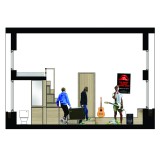The subject of my thesis is the creation of student housing, clustered in one complex, based on the study, incorporation and evolution of the idea of the neighborhood in a way that can be utilized in the urban landscape.
The neighborhood is an independent unit, with a finite number of people inhabiting a certain space, coexisting and affecting each other. It functions as a transitory stage between the city and the home and it has a unifying character, while it consists of the following polarisations: private-public, familiar-unfamiliar, specific-abstract, natural-manmade. All the elements that define the concept of the neighborhood can be summed up in three characteristics answering the following questions: Who does a neighborhood belong to? How does it work? What is it? A neighborhood belongs equally to its users, acts as a unifying element and is a living element.
Based on these three characteristics and their individual components, the housing units and public paces of the complex were designed incorporating concepts such as vague limits, escalating privacy and facilitating contact between user and space.
The project’s cornerstone is five housing units-rooms, separated according to the length of stay, which can be organized in various forms in a fixed structure. The structure’s repetition in conjunction with some general use areas in its ground floor can generate different complexes based on the needs of every location.
In this particular situation, as an example, four complexeshave beenplacedin one area of Volos. In a way that, the student residence and neighborhood become one part of the other.
